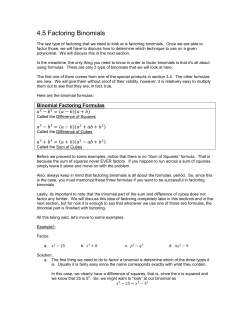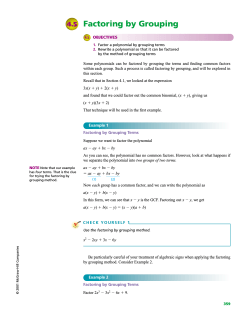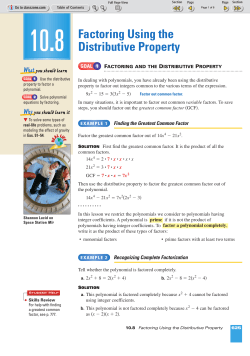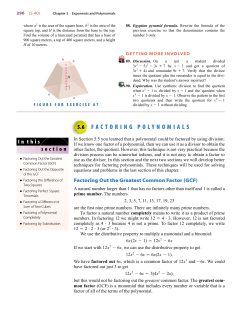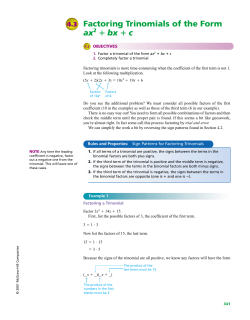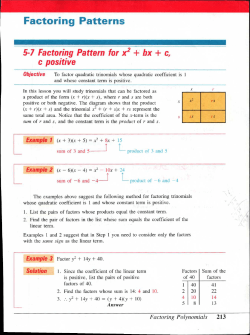
Factoring a polynomial is the process of writing it as the product of two or more polynomial factors. Set the factors of a polynomial equation (as opposed to an expression) equal to zero in order to solve for a
EAP/GWL Rev. 1/2011 Page 1 of 5 Factoring a polynomial is the process of writing it as the product of two or more polynomial factors. Example: — Set the factors of a polynomial equation (as opposed to an expression) equal to zero in order to solve for a variable: Example: To solve , ; , The flowchart below illustrates a sequence of steps for factoring polynomials. First, always factor out the Greatest Common Factor (GCF), if one exists. Is the equation a Binomial or a Trinomial? 1 Prime polynomials cannot be factored using integers alone. The Sum of Squares and the quadratic factors of the Sum and Difference of Squares are always Prime. Yes No Special Cases? Four or more terms Binomial (two terms) Trinomial (three terms) Factor by Grouping: 1. Difference of Squares: Perfect Square Trinomial: 1. 1 , 3 2. Sum of Squares: 1 , 2 3. Difference of Cubes: 2. 1 , 2 4. Sum of Cubes: 2 Use S.O.A.P to remember the signs for the factors of the Sum and Difference of Cubes: Same, Opposite, Always Positive 3 FYI: A Sum of Squares can be factored using imaginary numbers if you rewrite it as a Difference of Squares: — No Special √ 1 Cases 1. Group the terms with common factors and factor out the GCF from each grouping. 2. Continue factoring—by looking for Special Cases, Grouping, etc.—until the equation is in simplest form (or all factors are Prime). √ 1 4 Choose: 1. Factor by Grouping 4 2. Complete the Square 4 3. Use the Quadratic Formula This process is applied in the following examples Completing the Square and the Quadratic Formula are primarily methods for solving equations rather than simply factoring expressions. Also, if the GCF doesn’t contain a variable, it may not be necessary to factor it out prior to using either of these methods. However, doing so will provide smaller coefficients to work with. Factoring steps and most examples are adapted from Professor Elias Juridini, Lamar State College‐Orange. EAP/GWL Rev. 1/2011 Page 2 of 5 Factoring Examples Binomials: : First, divide each term by the 1. to get the Then, show the multiplied by the No special cases apply to the binomial . , so the factors are Factored: and . : This polynomial expression has no 2. . . However, it can be expressed as a : Use the square root of each term, . and √16 , … 4 to fill in the formula: Continue to factor another The next factor is a Factored: 3. : , which is . . : There s no to factor out, but you should recognize this polynomial expression as a : . Use the cube root of each term, 729 9 1 to fill in the formula: √1 • In the first set of parentheses, place each term to the first power: 9x 1 . • In the second set, square the first and the last term: 9x ? 1 o The middle term is the product of the first and the last: 9x 9x 1 1 o *Note that this quadratic factor is Prime! • Use S.O.A.P to remember the signs: Same in first set of parentheses; Opposite, followed by Always Positive in second set of parentheses. If and , then … Factored: . Trinomials: : There’s no GCF to factor out of this expression, so check for a Perfect Square 1. Trinomial— or ASK: •Are the first and the last terms perfect squares? and — ! •Is the middle term two times the product of the square roots of the first and last terms? Factoring steps and most examples are adapted from Professor Elias Juridini, Lamar State College‐Orange. EAP/GWL Rev. 1/2011 Page 3 of 5 First Term , Last Term , and √ √4 If “Yes” to both of the above: •Place the square roots of the first and last terms in parentheses: •Use the sign of the middle term: 2 •Square the whole thing: 2 If and √4 ( ) Factor by Grouping ( ) ! ? 2 , then … Factored: 2. — : Factor out the , , in this equation to get . Be sure the trinomial factor isn t a special case— it isn t— and select a factoring method. a. Try Grouping: • First, multiply the coefficient of the first term, 2, and the constant, 10: 2•10=20. • Then find the factors of this product, 20, that add/subtract to yield the coefficient of the middle term, which is 1. Factors of 20: 1•20, 2•10, and 4•5. Of these factors, 4 and 5 will subtract to give 1. Because the middle term is positive, we use +5 and –4. • Replace the middle term with –4 and +5: . o It’s important to order the two new middle terms so a GCF can be factored from , but not . each pair: • Group the first and last pairs of terms; factor out a GCF from each, and rewrite the problem: 2 4 5 10 2 2 5 2 . appears twice. If this doesn’t happen, reorder your middle terms. o Note that • Factor out the GCF—which is —and rewrite in factored form. • Remember to include the 2 factored out at the beginning when you write the whole equation in factored form Factored: • Recall that this example is an equation set equal to zero (not simply an expression). That means we can solve for x by setting each factor containing a variable equal to zero. or or Solutions: or *Always check by plugging your answers into the original equation to verify them! b. Now let’s solve the same equation, , by Completing the Square: • Make sure the equation is in the General quadratic Form— —and it is. • The GCF is 2, but you don’t need to factor it out—doing so will not affect the solutions. Factoring steps and most examples are adapted from Professor Elias Juridini, Lamar State College‐Orange. nge. □Completing the Square□ EAP/GWL Rev. 1/2011 Page 4 of 5 • Divide each term by the first term’s coefficient unless the first coefficient is already 1 : 2 20 2 20 • Isolate the constant on the right side of the equal sign. Then take ½ the middle term’s coefficient multiply by ½ or divide by 2 , square it, and add this number to both sides of the equation: 1 5 5 0 5 2 1 1 1 1 1 The is Take of and square it: 2 2 2 4 4 1 Add to both sides: 5 2 Use a common denominator to add fractions: • Now we have , which is a Perfect Square Trinomial on the left. *The point of Completing the Square is to create a Perfect Square Trinomial! Compare with the formula: In , √ and The middle term is , so it can be factored as The trinomial can be written as • Rewrite the equation with the left side factored: • The final step is to extract the roots and solve for x: or Solutions: or *The solutions are the same as obtained from the previous method! c. Finally, let’s try using the Quadratic Formula to solve the equation Quadratic Formula • Factor out the GCF to get : √ . Factoring steps and most examples are adapted from Professor Elias Juridini, Lamar State College‐Orange. EAP/GWL Rev. 1/2011 Page 5 of 5 Quadratic Formula • Note that factoring out the 2 will not affect the solutions, but it does result in smaller coefficients to plug into the Quadratic Formula. • Make sure the equation is in General quadratic Form, , and it is. • Identify a, b, and c in : , , • Plug these numbers into the formula and solve for x: √ √ or Solutions: or *Again, we obtain the same solutions as we did by other methods! More Than Four Terms: 1. : Factor the expression by Grouping and continue factoring until completely simplified. • Factor out the GCF, 5, to get another GCF can be removed from each grouping. and then group the terms so that • We are unable to obtain a pair of identical binomial factors (as in the earlier Grouping example). Therefore, no further factoring is possible and we see that the expression has only two factors, 5 and . Factored: 2. • • • : The terms of this expression appear to need no rearrangement. The first pair, , are a Difference of Squares and the second pair, , have a GCF of 3: Factor each pair: However, there is no GCF to factor out of these pairs of factors. The expression remains the sum of polynomial products rather than the product of two or more polynomial factors (the definition of the factored form). When one way of grouping doesn’t work, try another . . . Rearrange the terms to form a Perfect Square Trinomial and a Difference of Squares: This example is adapted from Factor the Difference of Squares: Gustafson & Fisk, College Algebra, 8th Factored: ed., Thompson Learning, Inc. 2004, p. 55. Factoring steps and most examples are adapted from Professor Elias Juridini, Lamar State College‐Orange.
© Copyright 2025





